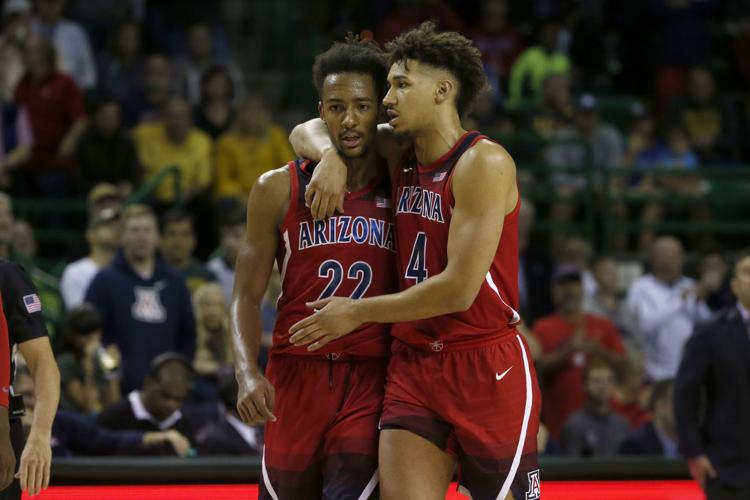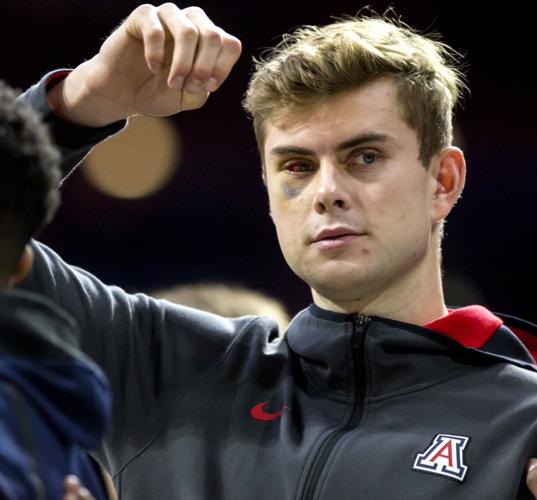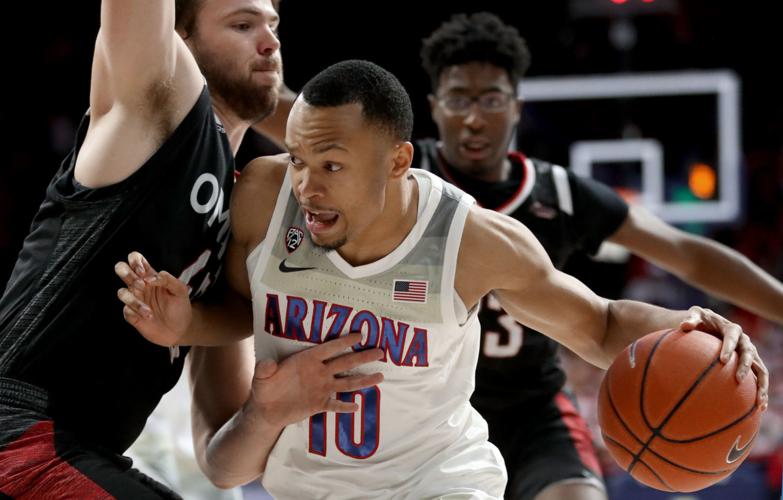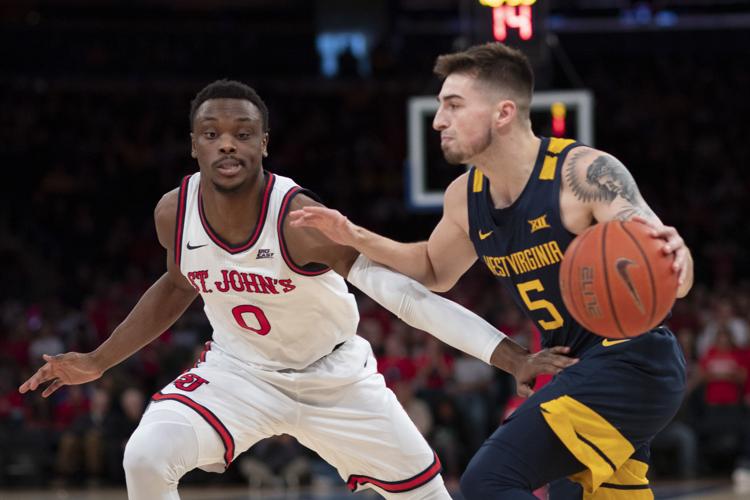With his team’s offensive efficiency having all but disappeared in two losses earlier this month, Arizona coach Sean Miller has been talking a lot about the necessity of patience lately.
“Playing quick? Gotta be smart as well,” Miller said Friday. “Taking a couple of ill-advised quick shots, ‘my-turn’ type of shots, the ball not being taken into the paint and posted. … When you play against a really good team, they use that against you, and Gonzaga did.”
In its 84-80 win over Arizona last Saturday, Gonzaga held the Wildcats to 38.5% shooting and just 8 of 30 from 3-point range. Things were even worse for the Wildcats a week earlier at Baylor, where the UA made just 26.9% from the field, including 2 of 18.
Even after wins, Miller has complained the Wildcats have sometimes been taking shots too quickly, not sharing the ball enough, not waiting for the right moment.
So what now? On Saturday, Arizona will be facing a St. John’s team that runs the 18th-fastest tempo in Division I, and presses routinely after made shots. The Red Storm ranks top 35 in defending two-point shots and is 25th in turnover percentage.
In short, they move fast, and they want you to move fast … so that you make bad decisions.
“They’re the fastest tempo team that we will play all season,” Miller said. “Some of that is just because of the way they play defense. … Sometimes they’re super aggressive and they just trap and they really try to create turnovers but St. John’s is an excellent team in transition.
“They force a high amount of turnovers, play at a very, very fast tempo, an excellent driving team. We have to be ready.”
Sophomore Jemarl Baker appeared confident they will be. The Wildcats have had two off days and four practices since losing to Gonzaga last Saturday, giving them time to rest, finish up final exams and prepare for their final nonconference game.
“They play really fast and we haven’t really played against a team that’s going to press as much as they do,” Baker said Friday, before the Wildcats flew to San Francisco. “We just have to stay poised, just think the game — try not to get sped up too much but we have to attack at the same time.”
Baker and Nico Mannion will be at the front lines of St. John’s pressure, though Mannion hasn’t had an issue with ballhandling — he has posted a 3.7-1 assist-turnover ratio in his last five games — as much as he’s struggled to shoot lately.
Mannion has shot just 24.1% from the field over his last four games, though Miller wasn’t necessarily blaming him for shooting too quickly more than anyone else.
“Somebody of his stature who doesn’t shoot the ball well, we’ve taken a look and there are a couple maybe where he could have been a little bit more patient,” Miller said. “But there were quite a few shots in that game that he normally makes and that’s part of it.
“But it’s a team game; you win as a team, you lose as a team. There are many, many possessions that had nothing to do with Nico shooting where we just took first-side shots, quick shots and played at a fast pace. You’ve got to be very smart.
“Just because we’re playing fast, which we want to do, doesn’t mean that we need to be rushed into taking a shot that’s not good for our team.”
Gettings remains out for Saturday

Arizona guard Jemarl Baker Jr. (10) fights his way around Nebraska-Omaha forward Matt Pile (40) in the second half of their game at McKale Center, Tucson, Ariz., Dec. 11, 2019.
Arizona forward Stone Gettings won’t play Saturday against St. John’s, Miller said, though he has returned partially to practices and will make the trip to San Francisco.
Miller said Gettings participated in noncontact drills this week after sitting out completely for two weeks following a concussion and facial fracture he suffered on Nov. 29 against Penn. He is wearing a mask to protect the fracture, though it is the concussion that has been holding him out of action.
“His face, his cheekbone, his eye, is not 100% but it looks a lot better,” Miller said. “The swelling’s down. … When we get back from Christmas he’ll be a month, and he’s moving in the right direction.”
Gettings is expected to return for the UA’s Pac-12 opener on Jan. 4 against ASU and wear a mask for that game, but Miller said he probably wouldn’t have to wear it past the six-week mark following the injury, which will occur during the UA’s trip to Oregon and Oregon State from Jan. 9-12.
“He clearly wants to play,” Miller said. “It’s just with a head injury and concussion, it’s really not up to him. It’s up to his symptoms and giving him the most time to recover, making sure that our medical staff OKs him, that he’s comfortable and has enough activity under his belt before he returns to the court.
“I believe all that will really be in place. Our hope is that when we get ready to play in the Pac-12 that he’ll will be fully recovered.”
Heron questionable

St. John’s Mustapha Heron (0) defends against West Virginia’s Jordan McCabe (5) in the first half of an NCAA college basketball game Saturday, Dec. 7, 2019 in New York. St. John’s won 70-68. (AP Photo/Mark Lennihan)
Meanwhile, St. John’s guard Mustapha Heron may be limited or sidelined with a sprained ankle he suffered against Brown on Dec. 10.
Heron sat out the Red Storm’s game against Albany on Wednesday but made the trip to San Francisco. Miller said he is preparing as if Heron will play, though St. John’s coach Mike Anderson said it would likely be a “game-time decision.”
Speaking on the Big East’s teleconference call Friday morning from San Francisco, Anderson said Huron was scheduled to test the ankle during practice later in the day.
“We’ll see if he’ll be good to go,” Anderson said. “It just depends on how he moves. He had a pretty good sprain there so we’ll just play it by ear.”
More rebounding concern

Arizona forward Zeke Nnaji (22) pulls down a rebound in front of Gonzaga forward Drew Timme (2) in the first half of their match-up between top 20 teams at McKale Center, Tucson, Ariz., December 14, 2019.
Already having said the Wildcats’ “Achilles’ heel” is rebounding, Miller added Friday that his current team is “one of the worst rebounding teams that I have had at Arizona.”
The Wildcats are outrebounding opponents only by 4.3 on average and allow opponents to rebound their missed shots 27.8% of the time. That’s only the 161st best defensive rebounding percentage of 353 Division I teams, according to Kenpom.
The UA is slightly better on the offensive glass, with the 96th best percentage at 31.0.
However, the Wildcats generally held their own against Gonzaga. They outrebounded the Zags 44-43, though the Zags had 12 offensive rebounds that led to 21 second-chance points.
“In the Gonzaga game, we did it better than we have, and we had some segments, like in the first eight minutes of the game, when we were dominant,” Miller said. “But to be able to sustain it for a 40-minute period — this is one of the worst rebounding teams that I have had at Arizona.
“We have to get better in that area. I believe we can get better. We have enough talent to improve in that area, but we have to do it. And it’s not just one person. It’s our guards. It’s our big guys. … Our reserves, our bench, we need more production from them in rebounding.”
Except forward Zeke Nnaji, that is. The freshman pulled down 17 rebounds against Gonzaga and is averaging 9.3 rebounds in his past six games.
“That’s more of what we need from him,” Miller said, “and he’s capable of doing that.”








